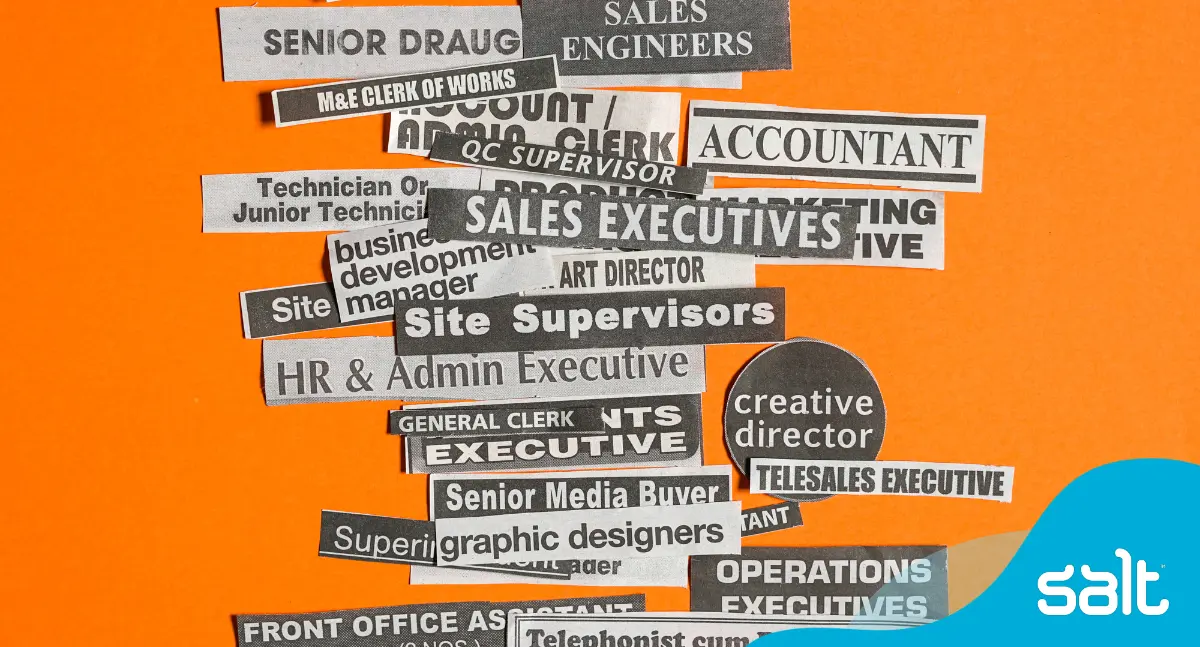
Technology is changing fast – and education isn’t changing fast enough to keep up. The digital skills gap is challenging every employer today. Here’s what you can do to source the skills you need.
The digital skills gap remains a key issue facing businesses today, even more so in the wake of technologies like AI disrupting the market and the way we work.
In many ways, the digital skills gap we’re able to point to now is just the tip of the iceberg.
Digital changes fast, and so does the marketplace. The real challenge for business leaders is trying to map and scope what they cannot see – an ever-changing and uncertain future.
Salt have seen first-hand how more and more employers world-wide are seeking digital skills needed to support their transformation so they can stay competitive and keep innovating.
We’ve also seen that candidates with these skills are in fierce demand and graduates lack the skillsets that are most needed. Gaps appear because there’s simply isn’t the supply to meet the demand.
According to Gartner, HR leaders (71%) rank growth as their top priority for their organisations. But digitalisation remains the key focus for businesses new and old, which means specific skillsets are needed to transform, grow and compete with the market.
To stay afloat and ahead in the race, business leaders are having to focus on the reality of the digital skills gap head on.
You can’t close the digital skills gap any more than you can draw a map of somewhere you’ve never seen. What you can do is empower an environment of change and continuous learning that will help you navigate which skills you need now and which skills you’ll need years from now. Here’s how.
Unchartered waters: what is the impact of the digital skills gap?
We can see the impact of the digital skills gap on the horizon. What it looks like is an almost unmeetable demand for skilled professionals in new emerging landscapes including web development, machine learning and AI tools to work flow processes and automation capabilities.
The digital skills gap is widespread, global and growing. It impacts productivity, innovation, agility and success.
Digital skills – like software engineering, programming, website development, app development, user experience and testing, analysis, AI and machine learning – are increasingly in demand.
Not only are there a growing number of tech start-ups hunting for these skillsets to launch in competitive marketplaces, but non-tech, traditional companies are rapidly digitalising and transforming to keep up with their competition.
This doesn’t just extend to expertise skills but to interpersonal skills as well – and in fact in Wiley’s 2023 Digital Skills Gap report they find that demand for expertise and technical skills has decreased 33% while demand for interpersonal skills has increased 48%. According to the same report, according to at least 40% of survey respondents, the three most in-demand skills most identified as lacking in-house were:
- strategic thinking and analytics (46%)
- digital communication (41%)
- project management (40%).
Without these skills in-house businesses are at a competitive disadvantage, and they’ll struggle to close the gaps between their employees’ current capabilities and what they need to succeed in this digital economy.
- 80% of IT professionals say that skills gaps pose a high or medium risk to their team’s ability to meet their objectives, according to the Skillsoft 2022 IT Skills & Salary Report.
- A study by Microsoft found that 65% of hiring managers worldwide report difficulty finding qualified digital talent.
- Only one in 10 (11 per cent) UK workers possess digital skills, research by Gallup and Amazon Web Services has found.
Below the surface: what does the digital skills gap actually look like?
With limited supply, organisations are competing for the same types of skills which, according to Gartner, fall into 3 main areas:
- Emerging skills
These are new skills driven by technological advancements, like new apps or platforms or languages. The emergence of Amazon Web Services, blockchain, machine learning and AI engineering are great examples.
- Evolving skills
Roles are changing as needs change, and as technology develops Companies strive to be efficient, accurate and competitive – so they continue to embrace big data, analytical and statistical skills, natural language processing and cloud engineering and more as the market demands they keep pace. Existing employees may have gained their skills through more legacy programs like SPSS and SAS are shifting to data-oriented tools like Python and Tableau.
- Expiring skills
With the rapid adoption of AI and machine learning, in some use cases technology can perform faster and cheaper than humans. Roles are shifting from manual to management of AI tools and processes. Examples include cold outreach, manual sorting, even designing for print advertising.
As these trends show, no skill set is future-proof. Even reliable in-house talent requires support and development to match the needs of the market.
This is an issue that needs urgent attention from business leaders – and it goes beyond the challenges of talent acquisition and growing your workforce.
More and more businesses are either digitalising to meet demands – or are being founded with a digital-first approach from the outset. Whatever the sector, whatever the role, the workforce are using digital tools and systems, which means the role requirements are more and more digital too! The skills gap impacts employers, employees and graduates alike.
Exploring the unknown: how to hire the digital skills of the future
Competition for experienced digital talent is fierce. Smaller businesses and start-ups are competing with established powerhouses of the Tech industry, some offering shares to compete with high salaries. Startups are disrupting markets, able to both scale up and pivot quickly without legacy technology slowing them down, and are competing for the same digital talent and skillsets.
It’s impossible to know and prepare accurately for what’s next in these fast-moving markets, but to prepare for the unknown and for disruptors, digital skills and a culture of continuous learning to keep these progressing will help you keep pace.
Here’s what you need to know to secure talent in a competitive jobs market.
To source talent with the competency and skills you need digitally, also consider a skills-based hiring approach and interview process. The benefits include not only broadening and diversifying your talent pool in a competitive job market, but also includes candidates your competitors may be overlooking, who are excluded from more traditional hiring processes.
How to hire the top talent of today and tomorrow:
- Take stock of where you are now and what you need to be by listening to the people and teams you have. Work with your HR and People department and with a third-party recruitment specialist or consultancy like Salt, to really identify the skill gaps you have today and how they’re blocking progress. There are many possible solutions and no one-size-fits-all approach, so take the time to review both the perspectives of leadership as well as employees doing the work day-to-day.
- Define your vision and your values if you haven’t already – and map this to your business practices, services and teams. What do they practically mean in the everyday lives of your workforce? What will they mean 5 years from now? These are your North Star and will be how you navigate changing and uncertain times – with your goals in sight and your staff on the same page.
- Compare the gaps you’ve identified (step 1) with the vision you have for the future (step 2). Consider anything that might not be immediately obvious in the day-to-day running of your business today that you’ll need to create your business in the future. Where you have more questions than answers, work with an expert or reach out to those further ahead in their transformation journeys to find the right vocabulary to articulate the skills you’re looking for. Once you have this, you can work with recruitment specialists to source and tap the markets these skills are in, or strategically invest in skills that will be able to evolve and manifest those skills in future.
- Understand your position in the competitive marketplace. What are your competitors doing and where are they going? How does their vision and values and practices differ to yours? How do they serve their customers or clients now and what promises do they make in the future? This is a way to test out your own perceived gaps, your strategic vision and company values in terms of how they compare and contrast to what’s out there in the market and in your niche.
How to traverse the skills gap and empower your workforce through upskilling
Gartner reports that 58% of the workforce will need to develop new digital skill sets to do their current jobs successfully and sustainably.
This need is matched by employee’s own desire to upskill – Gallup found that 57% of US workers want to update their skills, with a third of the America workforce having ‘limited digital skills’ according to the OECD.
In the UK, the Department for Education conducted research with small businesses across the UK technology sector finding that 46% of companies ranked a lack of staff with the right skills and difficulties hiring as their top two concerns for this year. Almost 80 per cent of those surveyed planned to invest in improving the skills of their existing workforce to counter the skills gap in house, in addition to their recruitment efforts.
How to upskill your staff with the future of digital in mind:
1. Invest in learning and development programs with a focus on skills and capabilities – and continue to review and adapt what’s on offer based on your needs as a business, trends in the market and around the world. This is a key factor in attracting talent in a competitive market. Here’s our advice.
2. Build learning and development pathways so your existing employees can upskill in areas like cloud computing, data science, artificial intelligence (AI), and machine learning. Also provide training and practical experiences like volunteering to develop long-lasting and evergreen skills like communication, leadership and management.
3. Develop mentorship programs internally and externally to provide employees with guidance and support from experienced professionals or peers with insight into developing specialist areas.
4. Foster an internal culture that empowers and encourages continuous learning, and that recognises and rewards employees who’ve proactively committed and seen results from their skills development journey.
Glossary: What is the digital skills gap?
The digital skills gap describes the unmeetable demand for skilled professionals with knowledge and experience in new and emerging technologies, from website development to machine learning and AI.
Hiring? Salt connects you to outstanding top talent worldwide
If you’re interested in hearing about how Salt’s top talent recruitment experts around the world can help with your hiring right now, get in touch. Click below to contact the closest Salt team to you!
- Australia
- Canada
- Belgium
- Europe
- Hong Kong
- Malaysia
- Middle East and North Africa
- Netherlands
- New Zealand
- Singapore
- South Africa
- United Kingdom
- United States
Keep up with Salt’s top talent job market insights and hiring advice! You can keep in the loop by following us on. LinkedIn, YouTube, Facebook, Instagram, and Spotify.


